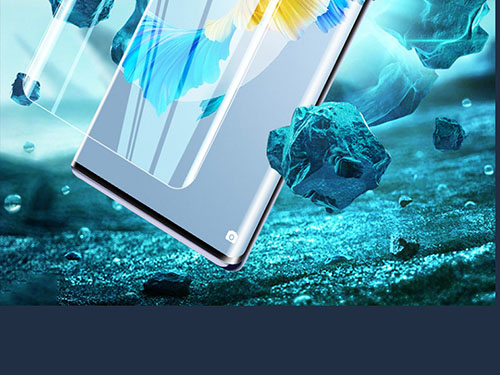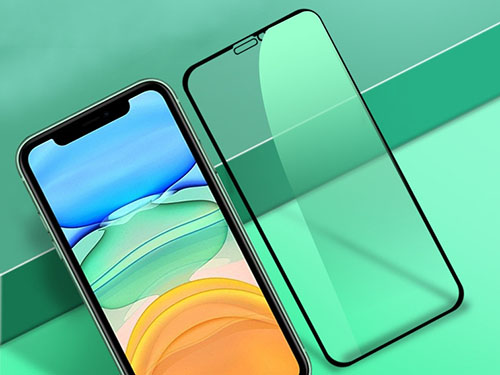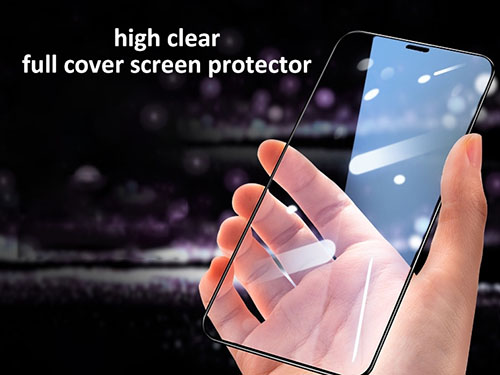17
2023-03
How is the mobile phone screen protector made?
How is the mobile phone screen protector made?
Tempered glass phone screen protector is currently the most popular advanced protective mask for mobile phones. Mobile phone tempered glass phone screen protector plays a very important role in the protection of our mobile phones, but many people don't know much about it.
The characteristic of tempered glass phone screen protector is the use of tempered glass material, which can play a better anti-scratch effect than ordinary plastics, and has better anti-fingerprint and anti-oil effects. And you can think of the tempered glass phone screen protector as the second outer screen of the mobile phone. If the mobile phone falls, the screen protector can indeed absorb a certain amount of damage and reduce the probability of broken screen.
Compared with other industries, the technical content of tempered glass phone screen protector is not high, which may be the opinion that most people will have when they think of tempered glass phone screen protector. But when we visited tempered glass phone screen protector manufacturers, we found in the process of in-depth understanding that the production process of tempered glass phone screen protector is not as simple as we imagined. The tempered glass phone screen protector has to go through a series of complicated processes before it can become a piece Beautiful finished product.
So how is the tempered glass phone screen protector produced? What raw materials are used for it, and what process is it used for? Today, the editor will take everyone to increase knowledge again.

1. Raw materials: There are differences in different raw materials for glass
Glass phone screen protector is made of different brands of glass raw materials. Since it is a tempered glass phone screen protector, the importance of its raw material - glass is self-evident. The original glass phone screen protector can be divided into two parts: domestic and imported according to the manufacturer. Asahi Glass (AGC), Board Glass, German Schott and American Corning. The cheap tempered glass phone screen protector is mainly made of domestic glass.
In terms of quality, high-end imports (Corning, Schott, Asahi Glass) > mid-end domestic (such as Glass) > low-end domestic (non-brand). AGC, SCHOTT, and Corning each have their representative products, and the quality of the top three products is on par with each other, and the difference is not very big. So what is the main difference between domestic and imported? The main difference between the two lies in light transmittance and price. The light transmittance of domestic materials can only reach 92% or even lower. Imported materials guarantee a light transmittance of more than 95%, which has a better visual experience. Of course, the price of imports is higher.
Of course, the smaller the thickness of the glass phone screen protector, the better the feel, the higher the fit, the better, and the thicker the worse the feel. Now if you need to buy glass phone screen protector, it is best to buy 0.2mm, which is relatively cost-effective. Now there are domestically produced glass with a relatively large thickness in the market. The thickness is less than 0.5mm, which is difficult to feel by hand. Whether it is 0.2mm and 0.3mm, or 0.3mm and 0.4mm, it is very difficult to distinguish . Therefore, there are some bad tempered protective phone screen protector manufacturers in the market to confuse consumers.
The glass phone screen protector with a thickness of more than 0.4mm is too thick and affects the hand feel, and it has basically been eliminated now.
0.3mm is the current mainstream entry-level thickness, but it still looks a little thicker, and the price is about 50 yuan.
0.2mm is the current mainstream high-quality screen protector, with excellent permeability and feel, and the price is slightly expensive, basically around 60 yuan.
0.10mm is the thinnest technology at present, and it is only for rich local tyrants who pursue the ultimate transparency and feel. If it is cracked, just replace it, and the price is mostly around 100 yuan.
Let’s talk about the 0.2mm tempered glass phone screen protector raw material. So far, the original thickness of the raw material is 0.2mm, and there are only two types of glass: American Corning and German Schott. There is also a 0.2mm tempered glass phone screen protector material, which is thinned by soaking a 0.33mm thick glass material in chemical liquid. The thickness of this thinned glass material will not be so uniform. The thickest part may be 0.25mm, and the thinnest part may be 0.22mm. The treated 0.2mm glass is worse than the original 0.2mm in terms of toughness and flatness. However, the cost is still much higher than ordinary 0.33mm glass.
Corning of the United States and Schott of Germany are able to achieve a thickness of less than 0.2mm on the market, and the cost is relatively high. However, there are a lot of cheap tempered glass phone screen protectors called 0.2mm and 0.15mm on the market. why is that? In fact, false thickness standards are an open secret in the tempered glass phone screen protector industry, and 0.3mm falsely claiming 0.2mm or even 0.15mm abounds. The difference in thickness is within 0.1, which is difficult to feel by hand. Therefore, the thickness of the false standard is an "open secret".
Both the tempered glass phone screen protector manufacturer and the tempered glass phone screen protector trader do not mark the thickness of the AB double-sided tape used on the tempered glass, resulting in concealing the true thickness of the tempered glass phone screen protector. Tempered glass phone screen protector products are composed of two parts: tempered glass + AB double-sided tape, of which the thickest AB double-sided tape is 0.2mm, the thinnest is 0.093mm, the real thickness of the so-called 0.4 thickness tempered glass phone screen protector products in the market is: 0.493 mm ~ 0.6mm.
2. Processing flow
Whether the quality of tempered glass can meet the standard, in addition to the reasons of glass raw materials, whether the setting of process parameters is reasonable is the decisive factor. Only by thoroughly understanding their functions and the relationship between them can we produce high-quality glass phone screen protectors. There are the following processes to determine the quality of the finished glass phone screen protector.
1. CNC carving: determine the shape and size
The rectangular small-sized glass processed through the first cutting process, and then the glass material is cut into a shape suitable for the mobile phone model through the CNC engraving machine, and the glass products that need to be punched and stepped, etc. Processing, and the difference between using a large engraving machine and using a general engraving machine lies in the hole position of the glass phone screen protector and the burr on the edge of the glass phone screen protector that cannot be seen with the naked eye. The inaccurate hole position is at most a poor user experience, but the size of the burr will directly affect the service life of the glass phone screen protector. And because the burr cannot be seen with the naked eye, it can only be seen with a microscope, so in this process, many small tempered protective phone screen protector manufacturers directly use knife molds in order to reduce costs.
2. Sweeping flat grinding: fine finishing
This process is to process the screen protector with a light sweeping machine, which can effectively remove scratches on the surface of the screen protector and increase the curvature and brightness of the edge of the screen protector to achieve smooth, beautiful and durable effects. Here I want to talk about the arc edge treatment. The arc edge is polished to a 2.5D arc edge around the straight-edge screen protector. The arc edge of the tempered glass phone screen protector has an additional chamfering process than the right-angle edge, which is more beautiful and more expensive. So why is this product more expensive after it has more 2.5D arc edges? The first is the cost of time, which will not be explained. The second is the scrap rate. The scrap rate of 2.5D glass phone screen protector is 30% higher than that of the right-angled glass phone screen protector, which directly increases the cost.
3. Tempering: the key step of screen protector
Generally, the semi-finished glass phone screen protector is placed in a tempering furnace heated to about 420 degrees for 3-6 hours of tempering treatment with potassium dichloride. Through the full exchange of Na ions and K ions in the glass, it forms on the surface of the screen protector. Stress layer, so as to achieve the effect of bending resistance and impact resistance, so as to protect the screen of the mobile phone, greatly increase the toughness, and ensure that even if the glass phone screen protector is broken, it will not cause harm to the human body.
The strength of the glass increases after tempering, and its compressive strength can reach more than 125MPa, which is 4 to 5 times larger than ordinary glass; the impact strength is also very high. When measured by the steel ball method, a 0.8kg steel ball falls from a height of 1.2m. Glass stays intact.
Not only the strength, but also the elasticity of tempered glass is much greater than that of ordinary glass. A piece of tempered glass of 1200mm×350mm×6mm can produce a bending deflection of up to 100mm after being stressed. When the external force is removed, it can still return to its original shape. The bending deformation of the glass can only be a few millimeters. When you get a glass phone screen protector, bend the upper and lower sides of the screen protector, the closer the two ends are, the better the tempering effect and glass toughness will be. After shattering, it has a very beautiful texture similar to spider webs, and the fragments are very small.
Regardless of the lamination of glass phone screen protector back glue, these three processes are the three processes most likely to produce defective glass phone screen protector. Cutting and polishing can cause glass edges to burst. The tempering time of the tempering furnace is not enough, and the material of potassium nitrate is not good enough, which will lead to a decrease in strength and toughness. Most of the defective products produced were eliminated during the production process, and a small number of defective products could not be detected by the naked eye, leaving dark wounds such as trachoma, etc., and entered the market as good products, which would break after a little use.
3. Ultrasonic cleaning: a necessary part
Next, the glass needs to be cleaned by ultrasonic waves and cleaning agent. After cleaning, scratches, water spots, fingerprints, grinding powder and dust are not allowed. Therefore, the effect of the clean room must be handled well.

4. Coating: determines the anti-oil effect
We noticed that the feel of the surface of the tempered glass phone screen protector is completely different from that of the plastic phone screen protector. It is smoother and very close to the feel of a mobile phone screen. Many manufacturers advertise that screen protectors can prevent fingerprints. In fact, it is accurate to say that the high-quality tempered glass phone screen protector can reduce the residue of fingerprints on the glass phone screen protector, but cannot completely eliminate the occurrence of fingerprints. The method is to add a layer of anti-fingerprint oil on the surface of the tempered glass phone screen protector, and this layer of anti-fingerprint oil coating can also ensure that the surface of the screen protector can be easily removed when there are stains. Regarding this anti-fingerprint oil treatment process, there are also high and low points.
There are only three oiling methods on the market: hand coating, spray coating and vacuum coating. Hand painting is a brush in one hand, and the sticky oil is applied to the glass. The disadvantage is that the anti-fingerprint effect is not uniform, and the anti-fingerprint oil is easy to fade. Spraying is to use a spraying machine instead of human hands to spray on the glass. A spraying machine costs about 20,000 yuan. The effect of this process is better than that of hand painting, but the disadvantage is that it is less durable. The actual situation is that when you use it for about 20 days, you will find that the anti-fingerprint effect has been greatly reduced, because the anti-fingerprint oil has been polished.
Vacuum electroplating is to put the glass in a vacuum space and spray oil into it. The oil droplets will turn into mist after encountering the vacuum environment, and then scatter on the glass. The cost of importing a vacuum coating machine is over one million. The difference is how well this layer of oil adheres. Vacuum electroplating has high requirements on the external environment and needs to be operated in a dust-free workshop.
The effect of tempered glass phone screen protector after electroplating anti-fingerprint oil process is that it feels smoother to the touch, and the effect is longer. Generally, it can last for more than 2 months.
4. Adhesive: directly affects the bonding effect
The electroplating of the screen protector mentioned above mainly refers to the coating treatment on the side where the glass phone screen protector and the hand are in direct contact. On the side where the glass phone screen protector and the mobile phone are in contact, a layer of epoxy resin AB glue needs to be pasted, so that it can be adsorbed to the mobile phone screen. The requirements for the environment are very high in this processing process, which needs to be completed in a dust-free workshop. processing.
What is AB glue? Tempered glass phone screen protector is not like ordinary plastic protective phone screen protector, which can be electrostatically adsorbed on the mobile phone screen. It needs to be pasted on the inner layer of the glass phone screen protector with a thin layer of flexible double-sided adhesive. This thin layer of flexible double-sided adhesive is called AB glue. . The brands of AB glue generally include NIPPA/Nipah (Japan), Toyo (Japan), TMS (Korea), and domestic ones. The use of AB glue directly determines the lamination effect and exhaust effect of the tempered glass phone screen protector.
At this stage, AB double-sided adhesive products with qualified quality are all imported (Japan and South Korea). Except for the above three manufacturers from Japan and South Korea, there are many quality problems in the AB double-sided adhesive produced by manufacturers in China and other regions, such as high thickness. , Poor light transmittance, easy to produce bubbles, snow patterns, warped edges, degumming and other phenomena. For example, after pasting the tempered glass phone screen protector just bought, it is found that the four corners cannot be compacted, and there are lines and other phenomena. It is very likely that the manufacturer used inferior AB glue.
5. Defoaming: advanced treatment after pasting
Defoaming This process is mainly aimed at the slight bubbles between the adhesive and the glass after lamination, and the glass phone screen protector is defoamed by the low temperature and high pressure of the defoaming machine.
6. Packaging: Beauty link
Finally, the products that have been processed and meet the requirements are inspected and packaged. During packaging, frosted bags are used for inner packaging to prevent AB glue from sticking to the packaging bag, and foam bags are used for outer packaging to protect them. Finally, they are packed.
The above is the general process flow, which seems very simple, but why are the products produced so expensive? In addition to the value of the raw material itself, in fact, the yield rate of the whole process is about 80%, because various processes in the production will cause damage to the screen protector. It is also obvious that the user experience is greatly reduced, so there will be many inspection procedures in the manufacturing process to ensure the quality of the screen protector in production.
The above is a simple process flow chart. It is not difficult to see that a lot of testing procedures are required, and defective products can basically only be scrapped, which is why the screen protector is expensive, and the defective rate is too high.

Three, the end
This is how a piece of glass becomes a piece of screen protector. After dozens of times of processing and testing, just like steel needs to be tempered to become a good piece of steel. With the development of science and technology and the improvement of people's living standards, consumers will have higher and higher requirements for product quality, so there will never be an end to the road of pursuing excellence and perfection. There is still a long way to go, and we still need to devote ourselves to seeking, and share our encouragement with all screen protector practitioners!
Contact With Us
If you are willing to cooperate with us, you can contact us by leaving a message below.We will contact you as soon as we receive the information!
Contact information
sales04@weaddu.com
Phone number
+8619902626141
Tel
+86-0769-22820683
Address
Building 1, No. 20, Caotang Road, Gedi Community, Nancheng District, Dongguan City, Guangdong Province, China
